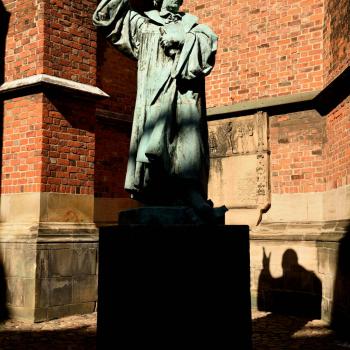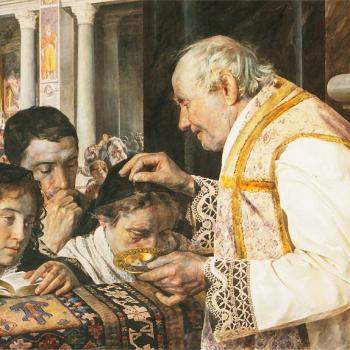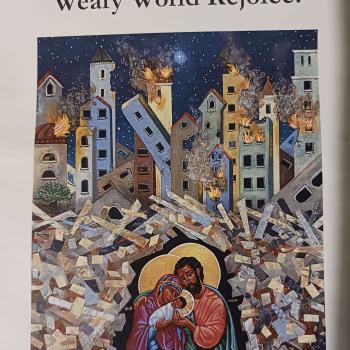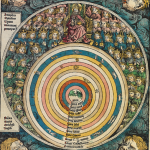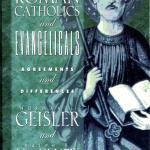On this anniversary of the 1527 martyrdom of Swiss Anabaptist leader Michael Sattler, his witness is being commemorated in a new way: not for the heroism or heresy (depending on who you ask) of breaking with the Catholic Church, but for his uncompromised commitment to social justice and nonviolence that now serves as a rich foundation for bridging the Anabaptist Mennonite and Catholic Benedictine traditions.
This commemoration is a milestone in the nascent project of my dear friends and mentors Ivan and Lois Kauffman, who conscientiously brought their Mennonite heritage into the Catholic Church long before it was cool. Their recent establishment of the Michael Sattler House, intended to provide renewal and connections to people involved in service and social justice, as well as to connect the spiritual resources of the Anabaptist and Benedictine traditions, has additional significance as a contribution to the emerging conversation around ecumenical martyrology. As Gerald Schlabach, another “Mennonite Catholic,” has written,
The memory of sixteenth-century persecution at the hands of both Catholics and Protestants runs deep in the Mennonite psyche. But a Mennonite witness to the nonviolent love of God—extending even to enemies and reconciling what has been broken by sin—will fall short if it becomes the basis for defining ourselves in opposition to other Christians.
Hence the need to honor the martyrs of our divergent Christian traditions in fresh, ecumenical ways. And the simple fact that Catholics can now recognize Sattler as a martyr 485 years after his death (including a significant affirmation in this morning’s homily at Mass!) is being heralded by Catholics and Mennonites together as a meaningful breakthrough.
Ivan Kauffman writes in an open letter to Mennonites and Catholics, “We cannot change the past, but we can change our perception of it.” My own perception of Michael Sattler’s story had been colored by the film The Radicals, a polemical portrayal of the Swiss Anabaptist movement that reinforces the popular Mennonite narrative of a fallen Church. Because of this, I had some initial discomfort with Sattler’s prominence when his namesake project was being planned. But I have since found Ivan’s insistent portrayal of Sattler as a witness to peace and justice at any cost, rather than an anti-Catholic polemicist, to be a compelling retrieval of the profound connections between the Benedictine tradition that formed him and the Anabaptist tradition that he helped to form. I have been struck by summaries of Benedictine values (awareness of God, community living, dignity of work, hospitality, justice, listening, moderation, peace, respect for persons, stability, stewardship), observing that such a list could easily be titled “Mennonite values” without having to change any part of it. I am grateful for Sattler’s influence in bringing these values into the Anabaptist tradition I inherited, just as I have in some way brought them back with me and tried to draw them out more strongly in the Catholic Church that I am now a part of.
History, of course, is a subjective science, and this ecumenically-oriented telling of it has its own intentions as surely as a more polemical one does. I do not have the historical expertise to offer an authoritative evaluation of any competing portrayals of Sattler’s life and legacy. What I can say is that this non-polemical reading of his story, while ecumenically groundbreaking, is not a de novo invention. An intriguing 1987 article by Abbot Eoin de Bhaldraithe (excerpted here) argues a number of strong connections between Benedictine monasticism and Anabaptism in Sattler’s theology, without glossing over the ruptures that did occur. Sattler’s markedly irenic approach is certainly evident in his articulate defense at his trial, in which he consistently addresses his accusers as “servants of God” (a far cry from the harsher rhetorical tone of certain other Anabaptist leaders). In recent decades, events such as Vatican II and various ecumenical dialogues have opened the way for reevaluations, on both sides of the Reformation divide, of what Sattler stood for, as Ivan Kauffman articulates in his open letter:
We have come to believe that Catholics can now understand Michael Sattler as a martyr for beliefs that were adopted as official Catholic doctrine at Vatican II, in the Declaration on Religious Liberty. And that Mennonites and Amish can now view Michael Sattler not only as one of their major founders, but as one who brought with him many of the riches of the pre-Reformation Benedictine tradition in which he was formed, and on which their own traditions are based.
To describe Sattler as an early Mennonite Catholic is not simply an easy capitulation to the false ecumenism that believes our differences don’t really matter. It is a recognition that he exemplified the best in both traditions, and that he combined them into a new ‘lay monasticism’ which has survived for 500 years, producing the first fully nonviolent lay Christian community in the Church’s history….
Michael Sattler was a martyr for things a vast number of Christians now agree on. The time for mutual accusations of heresy is long past. All Christians now together face a completely new set of erroneous beliefs—that Christian faith is no longer necessary; that we can be Christians without a commitment to costly lay discipleship; that it no longer matters that the Church is divided and in effect at war with itself; that traditional Christian doctrine and morality are now out of date and can be safely ignored.
Judging others, both inside and outside the Church, rarely if ever helps them—or the persons who judge. What does help is listening, as St. Benedict instructed his followers, “Listen with the ear of the heart.” Surely if members of the long-estranged Mennonite and Catholic communities will listen together with the ear of our hearts the wounds of the past can be healed and we can together become truly a peacemaking Church.
Convinced, therefore, of this martyr’s presence among the communion of saints, today we dare to say: Michael Sattler, Benedictine and Anabaptist, pray for us.





